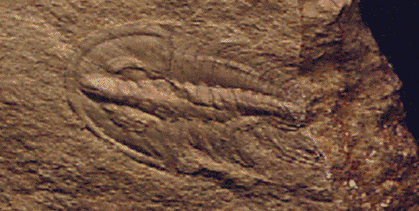
543 to 490 Million Years Ago
The Cambrian Period marks an important point in the history of life on earth; it is the time when most of the major groups of animals first appear in the fossil record. This event is sometimes called the "Cambrian Explosion", because of the relatively short time over which this diversity of forms appears. It was once thought that the Cambrian rocks contained the first and oldest fossil animals, but these are now to be found in the earlier Vendian strata.
The Cambrian period, part of the Paleozoic era, produced the most intense burst of evolution ever known. The Cambrian Explosion saw an incredible diversity of life emerge, including many major animal groups alive today. Among them were the chordates, to which vertebrates (animals with backbones) such as humans belong.
What sparked this biological bonanza isn't clear. It may be that oxygen in the atmosphere, thanks to emissions from photosynthesizing cyanobacteria and algae, were at levels needed to fuel the growth of more complex body structures and ways of living. The environment also became more hospitable, with a warming climate and rising sea levels flooding low-lying landmasses to create shallow, marine habitats ideal for spawning new life-forms.

Geography
Reconstructions of Cambrian geography contain relatively large sources of error. They suggest that a global supercontinent, Pannotia, was in the process of breaking up, with Laurentia (North America) and Siberia having separated from the main mass of the Gondwana supercontinent to form isolated landmasses. Most continental land mass was clustered in the southern hemisphere.
With a lack of sea ice – the great glaciers of the Marinoan Snowball Earth were long melted – the sea level was high, which led to large areas of the continents being flooded in warm, shallow seas ideal for thriving life. The sea levels fluctuated somewhat, suggesting that there were 'ice ages', associated with pulses of expansion and contraction of a south polar ice cap.
The Trilobites
One species was so plentiful and had such great numbers and so many species that it is sometimes called the ruling species of the period. This species was the

The trilobite was an arthropod with a tough outer skin. It got its name from the three lobes in the hard skin. The trilobite was also one of the first animals to have eyesight. During the Cambrian there were more than 100 types of trilobites.
Cambrian Period PikiaOther Invertebrates

There were plenty of other species living during the Cambrian Period also. Mollusks, worms, sponges and echinoderms filled the Cambrian seas.
No Backbones Yet, But...
There was even an early type of chordate living during the Cambrian Period. It was the Pikaia. Pikaia looked a bit like a worm with a long fin on each side of its body. The nerve cord was visible as a ridge starting behind the head area and extending almost to the tip of the body.

The Top of The Food Chain
One of the most fearsome hunters in the Cambrian seas was the Anomalocaris.Cambrian Peiod anomalocaris This animal had an exoskeleton like an arthropod, but it did not have the jointed legs that would make it a true arthropod. This large animal fed on trilobites and other arthropods, worms and mollusks.
Sponges
Sponges grew in Cambrian seas, too. These animals belong to the phylum porifera because of all the tiny pores in their bodies. One species of sponge from this period had many branches that made it look like a tree. Another type of sponge looked like an ice cream cone-without the ice cream, of course! Many of the sponges became extinct when temperatures dropped at the end of the Cambrian period.
Hard Parts
Many of the creatures living in the Cambrian seas developed hard structures for defense, hard shells, scales, and spikes covering the outside of the body. The Wiwaxia lived on the bottom of the sea. The dorsal side of its body had scales and spikes for protection. The underside of Wiwaxia was soft and unprotected. Trilobites also living on the bottom could burrow under the Wiwaxia and attack the defenseless belly.
Hallucigenia stood on seven pairs of tall legs. Its long, tube-shaped body had two rows of tall spikes along its back. This type of protection would have been very important for the animal because it had no eyesight to warn it of dangers.
Plants
The plants of the Cambrian were mostly simple, one-celled algae. The single cells often grew together to form large colonies. The colonies looked like one large plant.

Mass Extinction
The Cambrian Period began with an explosion of life forms. It ended in a mass extinction. Advancing glaciers would have lowered the temperature of the shallow seas where so many species lived. Changes in the temperature and the amount of oxygen in the water would have meant the end for any species that could not adapt.
No hay comentarios:
Publicar un comentario